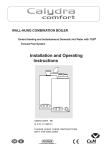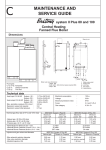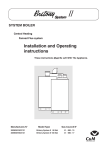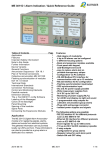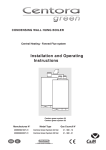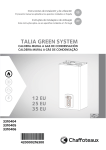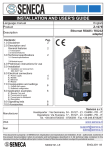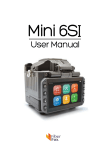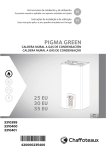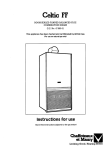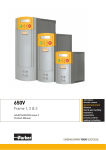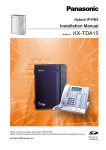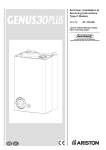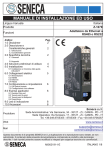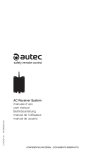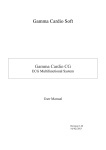Download 1310558d guide Cent. #FF19B.qxp
Transcript
c MAINTENANCE AND SERVICE GUIDE Fanned Flue Condensing Central Heating System Boiler 24 and 30 Dimensions Outer case dimensions : 440 (minimum space required 450) - Width : 850 - Height : - Depth : 380 (24kW) - 405 (30 kW) 360 360 50 50 212 212 67 67 737 850 737 850 235 232 L NJ 32 24380 : 380 30 : 405 Flue types: C 13: C 33: C 53: I J L N Safety valve outlet Heating flow Gas supply Heating return Safety valve center line 108 108 88 J L N I All dimensions in mm Technical Data 24 kW 30 kW Heat gross input C/H maxi ............................ 9.2-27.8 kW 10.4-31.6 kW Heat output C/H 50°/30° maxi ....................... 9-26 kW 10-30kW Heat output C/H 80°/60° maxi ....................... 8-24 kW 9-28 kW 80°C max 80°C max C/H operating temperature............................ 0.7 bar 0.7 bar C/H circuit pressures Min operating .............. C/H circuit pressures Max operating ............. 2.5 bar 2.5 barr 3 bar 3 bar Safety discharge ........................................... Expansion vessel - Pre-charge pressure ...... 0,7 bar 0.7 bar Net capacity at 3 bar in liter........................... 5.44 5,44 Supply ........................................................... 230 v 230 v Consumption ................................................. 150 w 150 w Protection ...................................................... IP 44 IP 44 Fuse F1/F2/F3/F4 ......................................... 2 A/1.25 A/0.315 A/0.250 A 24 v 24 v External controls ........................................... 24 kW 30 kW Natural gas G20 Gas rate C/H max ................... 2.64 m3/h Gas rate C/H mini.................... 0.87 m3/h Gas valve restrictor diameter .. without 3.01 m3/h 1 m3/h without Propane L.P.G G31 Gas rate C/H max. .................. 1.94 kg/h Gas rate C/H mini.................... 0.64 kg/h Gas valve restrictor diameter .. 4.40 mm 2.21 kg/h 0.73 kg/h 4.80 mm Pump and Expansion Vessel Characteristics Pump head available Pf Pression froid pourinitial le circuit chauffage (en bar) Centralàheating pressure when cold (in bar) Hauteur manométrique mCE 6 2,0 Minimum flow(robinets rate (with all heating thermostatic valves closed) Débit mini thermostatiques fermés) 1,9 1,8 1,7 5 GV F 4 3 GVO 2 40°C 1,6 1,5 1,4 50°C 1,3 1,2 PV F 60°C 70°C 1,1 PVO 1 0 100 200 300 400 500 600 700 800 900 1000 1100 1,0 0,9 0,8 0,7 l/h 80°C C liter 20 40 60 80 100 120 140 160 180 200 220 240 260 Capacité System capacity chartmaximale de l'installation (en litres) GV F= high speed by-pass closed GVO = high speed by-pass open PV F= low speed by-pass closed PVO = low speed by-pass open Note : The system initial pressure should be over the following value : System static height (in metre) + 0.7 = Initial pressure (in bar) 10 Components Location 1.- Steel chassis complete with expansion vessel (not visible) 2.- Sealed chamber 3.- Burner and heat exchanger assembly 4.- Air / gas connection 5.- 24 V modulating fan 6.- Gas valve 7.- Ignition electrode 8.- Ionisation probe 9.- Ignitor 10.- Combustion products manifold 11.- 24 V transformer 12.- Siphon 13.- Electrical box 14.- Pump 15.- Shunt plate 16.- Pressure gauge 17.- Silencer 18.- Automatic air separator and automatic vent 19 - Central heating flowswitch 21.- Central heating control thermistor 23.- Overheat sensor 37.- Central heating flow isolating valve 39.- Gas service tap 41.- Central heating return isolating valve 43.- Central heating pressure relief valve 46.- User’s guide 47.- Connecting tails (x3) 48.- Condensate drain 49.- Adjustable by-pass 50.- Right hydraulic assy 51.- Left hydraulic assy 10 11 7 1 2 9 3 8 4 12 5 6 17 23 48 15 13 14 16 23 18 19 1 3 0 21 4 bar 50 51 46 47 49 37 39 41 43 2 FUNCTIONING Control Panel 33 34 35 36 24.- Display 27.- Setting key 28.- Setting key 29.- Central Heating switch 30.- Green indicator – Central Heating mode ON 31.- Central Heating temperature reducing key 32.- Central Heating temperature increasing key 33.- Green indicator – Power ON 34.- Orange indicator - Burner ON 35.- Red indicator - Lock out / flame failure 36.- Reset key 32 31 29 30 24 27 28 Switching on 1. Check that pressure in central heating system is above 0.7 bar and below 1.5 bar with the pressure gauge 16. 2. Check that the gas service tap is opened at the gasmeter and main power is on. Green indicator Power ON 33. 3. Open the gas tap 39 (fig.21). The boiler is now ready to use. Attention ! If the boiler stays a long time without working, some air in the gas pipe can hinder the first lightings. (please refer to paragraph 19 Incorrect Function) Switching on Central heating Press on key 29 , the green indicator 30 will light and the display will show the Heating flow temperature. Keys 31 and 32 allow to adjust the temperature required in the Central Heating system regarding the weather conditions. • press to increase temperature when weather is cold • press to reduce temperature when weather is fair During the temperature setting operation the display will flash. If the room thermostat is calling for heat, a dot will be displayed at the bottom of the 3rd digit Stand by mode A fixed digit at the centre of the display and the green indicator 33 on Putting the boiler in stand by mode and anti freeze system. : Press on key 29 , to switch off CH mode. The green indicators 30 will stop. During the all duration of the stand by mode, an automatic anti-sticking system will switch on the pump for 1 minute and make a movement of the 3 way valve each 23 hours. The stand by mode will disable the anti-freeze function of the room thermostat (if fitted). To leave the room thermostat anti freeze system operative, please let the Central Heating mode on. The boiler is equipped with an automatic anti freeze system which permanently on. If the Central Heating temperature decrease bellow 7°C, the pump will start. If the Central Heating temperature decrease bellow 4°C, the pump and the burner will start. Turn off the boiler - Press on key 29 , to switch off CH mode. The green indicators 30 will stop - Switch off the main electrical supply - Shut off the gas service tap 39 (fig. 21) Note : In this conditions, the anti-freeze system is inoperative 3 Central Heating Mode To be able to supply heating, the mode should be switched ON. Press on key 29 , the green indicator 30 will light, and the display will show the Heating Flow temperature. Keys 31 and 32 allow to adjust the temperature required for Central Heating system regarding the weather conditions. During the setting operation, the display will flash. When there is a demand for heating, (either from the room thermostat or the clock) the pump starts. If the boiler temperature control is calling for heat and the primary flow rate over 4 lt./min., the central heating flow switch operates, allowing the ignition sequence to begin. The fan on the gas valve assembly starts and when the lighting speed is reached (detected by a hall effect sensor) the 2 safety solenoids open together to allow gas to the burner. The ignition sequence begins and a continuous high speed spark ignites the gas. As soon as a flame is detected, the orange indicator led 34 will light and the regulation system will be able to adjust the gas rate regarding the heat load. If a flame is not detected, after 10 seconds, the security solenoids close together and shut off the gas. The red lockout indicator led 35 will light. Press the reset button to re-light the burner. The central heating flow temperature is controlled by the central heating control thermistor 21. The boiler has been designed to minimise cycling and will not attempt to re-light for at least 3 min. after the boiler thermostat has been satisfied. When the room thermostat is satisfied , the burner will switch off and the pump will remain running for a further 3 minutes before it too stops. Note It is possible to override the 3 minute delay by pressing the Reset key 36 Lockout procedure Flame disappearance : When the ionisation electrode 8 does not detect flame presence. The orange indicator led 34 extinguishes. A lighting cycle starts. If a flame is not detected, before 10 seconds, the safety solenoids will close. The lockout red indicator 35 lights and the display shows the error code. The pump continues to run. After a few seconds, it will become possible to reset the boiler by pressing the reset key 36. Overheat detection : If an overheat (over 100°C) is detected in the primary circuit by the sensor 23, the safety solenoids close and the fan stops. The orange led 34 extinguishes and the pump remains running for 3 minutes. The reset will be possible when the primary temperature will decrease under 76°C. 4 CENTORA GREEN FUNCTIONAL DIAGRAM 3 7 8 5 6 12 23 48 13 21 19 16 18 14 49 37 39 41 ELECTRICAL WIRING DIAGRAM 5 43 ACTION DISPLAY CONFIGURATION Menu - 1 - Default register Record the last 10 defaults 5” Section x times Digit 1 Digit 2 and 3 Last default occured 0• code from 01 to 99 Last but one default occurred 1• code from 01 to 99 ... ... code from 01 to 99 Last default occurred before the previous one 9• code from 01 to 99 Note -- is displayed if no default is recorded. Menu - 2 - Boiler conditions Indicates the conditions or the configurations of the boiler once x times Section Digit 1 Digit 2 and 3 Software version of display PCB 0• 10 to 99 Flue type 2• 1 : FF variable speed Room thermostat is calling for heat 3• 0 : no 3• 1 : yes CH flow temperature in Celsius degrees 7• from 00 to 99 Software version of main PCB 9• 10 to 99 6 ACTION DISPLAY CONFIGURATION once Digit 1 Section Under floor heating system 0 Factory setting Menu - 3 - Boiler options Digit 2 and 3 0 : no 1 : yes x times DISPLAY CONFIGURATION Menu - 4 - Boiler settings Section Digit 1 Digit 2 and 3 0 0 : Burner only 0 1 : Burner and pump 1 0 : High speed 1 1 : Low speed Pump post circulation duration 2 0.0 min From 0 to 5 minutes by step of 0.5 min. 2 0.5 min 2 1.0 min 2 5.0 min 4 50°C 4 80°C CH anti cycling delay 8 0.0 min From 0 to 7 minutes by step of 0.5 min. 8 0.5 min 8 2.5 min 8 5.0 min 9 Value from 0 to 10 9 Value from 0 to 10 once Room thermostat operation x times Pump speed Maximum Central Heating flow temperature CH maximum output limitation Model 24 From step 0 (P. min.) 8 kW to step 10 (P. max.) 24 kW Model 30 From step 0 (P. min.) 9 kW to step 10 (P. max.) 28 kW 7 Factory setting ACTION ACTION DISPLAY CONFIGURATION Menu - 5 - Combustion rate control mode press once Display Effect wait 5 ” Combustion rate control mode OFF Switching on the combustion rate control mode. Central heating output reach the maximum power set in menu 4 section 9. Central heating temperature is displayed in celsius degrees. The 3 dots indicate that the combustion rate control is ON at maximum output. XX Switching the combustion rate down to minimum power. Central heating temperature is displayed in celsius degrees. The dot indicates that the combustion rate control is ON at minimum output. XX press once press once press once Switching on the combustion rate to Central heating temperature is dismaximum output set in menu 4 secplayed in celsius degrees. tion 9. The 3 dots indicate that the combustion rate control is ON at maximum output. Switching off the combustion rate control mode. press once Locking conditions of the combustion rate control mode : - boiler in stand by mode - room thermostat is not calling for heat - room thermostat is calling for heat but the maximum temperature is reached - boiler in lockout mode - after a reset or if the main supply fails - end of the mode if operator leave menu 5 - after 15 minutes if there is no actions on keyboard Nota : As soon as the combustion rate control mode is on, Central Heating key is inactive. 8 XX Adjustments and Settings (continued) 9 CH heat output setting : If you would like to change the setting of C/H heat output, please proceed as follow : (note : the factory setting is 18 kW and the following explanation refer to menu 4 section 9) Display 1 1 - Switch to installer mode, press key and 5” on the Right side for 5 seconds. The display shows : -1- then 0•-- if there is no default in the default register. 2 - press 3 times on menu key (on 2 x3 the Left side ) to gain access to menu 4-, The display shows : -4- then the value set for section 0 ( 00 or or 01 respectively Action on burner only or pump and burner) 3 - change for section 9 (Adjustment of CH heat output). Press on key on 3 x9 Right side 9 times. The display shows : (906 which corresponds to the 18 kW which is the factory setting) 9 = section 9 4 06 = 18 kW - press on setting key (on the Left side) once, the 2nd and 3rd digits flash 4 together. Then press the key on the DHW or CH side to change the C/H heat output steps between 00 and 10. Press on setting key to confirm the value. The display stops flashing. Setting procedure is finished. To exit from setting mode, leave the boiler for approx. 1 minute then the computer will switch back to user mode. After programming please close the door P (fig. 18) 9 REGULATION FLOW SWITCHES Temperature regulation for C/H circuit is controlled by 1 thermistor. The C/H knob allows the adjustment of temperature between 35 and 85°C. Resistance value are - 5000 Ω at - 2631 Ω at - 620 Ω at - 255 Ω at 25 °C 40°C 80°C 110°C Flow in Heating circuit is detected by 1 flow switche. A piston with a magnet at the top operates a REED switch. The piston is lifted by flow rates listed below : Flow rate threshold : C/H 250 l/h ±20 l/h ROUTINE SERVICING To ensure continued efficient operation of the appliance, it is recommended that it is checked and serviced as necessary at regulars intervals. The frequency of servicing will depend upon the particular installation condition and usage, but in general, once a year should be adequate. It is the law that any service work must be carried out by a competent person such as your local Chaffoteaux Service Centre, British Gas or other CORGI registered personnel in accordance with the current Gas Safety (Installation and Use) regulation. Attention ! the air/gas connection pipe between the gas valve and the burner should never open. The seal can be checked only in the factory. The service schedule should include the following operations : - Check the pressure in the system - Check the correct operation of the appliance - Check the correct operation of the gas controls - Check the functions of safety controls - Clean the electronic board of the fan located on the gas valve assembly and the different transformers in the sealed chamber. - Check combustion chamber insulation panels for damage - Check the lighting and ionisation electrodes condition - Clean the burner (Never use metallic brush which can damage the stainless steel) - Clean the heat exchanger (Never use metallic brush which can damage the stainless steel) - Clean the siphon and pay attention to the acidity of its contents - Check the correct seal of the drain system - Clean gas and water filters - Check expansion vessel charge pressure - Clean an check operation of safety valve - Check the correct seal of the flue system. Additional procedures that may be necessary : - Check the burner pressure and the gas flow rates - Check, clean or replace components as necessary - Carry out combustion test utilising the test points in the flue turret Suggested sequence for servicing : Before disconnecting or removing any part, isolate the gas and electricity supplies. Ensure that the appliance is cool, and take care about the condensats products content in the siphon which are acid. (For detail, please see section on Parts Removal and Replacement) Preliminary checks - Remove outer case - Check the system pressure is at least 0.7 bar cold - Check that the burner is extinguished fully when both solenoids are closed and fan is off. - Test ionisation functions and check that lockout occurs by turning off gas tap. - Whilst boiler is operating, check operation of the primary flow switch by closing heating flow valve and by pass screw (turn clockwise ) noting the number of turns so that it may be reset correctly. - Control the correct flood of condensats in the siphon which is transparent. 10 REMOVAL AND REPLACEMENT OF PARTS Before removing appliance case, isolate the gas and electrical supplies. Isolate boiler from the system and drain before removing any component in the waterways. Ensure that the appliance is cool. 1. Outer Case Remove four screws in base of case and lift free. When replacing, carefully locate on lugs T on top edge of chassis. 4. Ionisation electrode Carry out step 1 and 2 as above. Disconnect ionisation electrode from its wiring. Loosen the 2 screws and pull it out from the combustion chamber front panel. Replace the ionisation gasket provided. Reassemble in reverse order 5. Lighting electrode Carry out step 1 and 2 as above. Disconnect lighting electrode from its wiring. Loosen the 2 screws and pull it out from the combustion chamber front panel. Replace the ionisation gasket provided. Reassemble in reverse order. 10. Venturi in the gas section Carry out all operations mentioned in step 7. Unscrew the three screws securing the air/gas connection pipe onto the gas valve assembly. Separate the gas valve assembly and the venturi from the fan assembly by loosen the two hexagonal head screws. The venturi and the gas section can be separated loosing the 2 screw located at the top of the gas valve. Replace necessary gaskets before reassemble in reverse order. 11. Drain down 2 drain points are located on the boiler . 1 A A A A T 6. Burner Carry out step 1, 2 and 3 as above. Remove the 4 Philips screw retaining the burner onto the combustion chamber. Pull it out with care to avoid any damage to the ceramic panel protecting the combustion chamber front panel. Replace the burner gasket. Reassemble in reverse order. T 1 2 2. Sealed chamber front panel Unscrew four self taping screws securing the sealed chamber front panel and lift over top corner locating lugs. Reassemble in reverse order. 3. Combustion Chamber front panel and air/gas connection Carry out step 1 and 2 as above. Unscrew three screws securing the air/gas connection pipe onto the gas valve assembly. Disconnect Ionisation and lighting electrodes from their wiring. Unscrew six nuts to release combustion chamber front panel and pull the assembly towards you. Reassemble in reverse order. 7. Gas vale assembly Carry out step 1 and 2 as above. Unscrew three screws securing the air/gas connection pipe onto the gas valve assembly. Disconnect the connectors from gas solenoids and fan. Loosen the gas pipe nut. Unscrew six nuts to release combustion chamber front panel and pull the assembly towards you. Replace gas filter before fitting the full assembly back in the boiler. 8. Fan assembly Carry out all operations mentioned in step 7. Unscrew the three screws securing the air/gas connection pipe onto the gas valve assembly. Separate the gas valve assembly and the venturi from the fan assembly by loosen the two hexagonal head screws. Reassemble in reverse order and replace the necessary gaskets. 9. Gas section Carry out all operations mentioned in step 7. Unscrew the three screws securing the air/gas connection pipe onto the gas valve assembly. Separate the gas valve assembly and the venturi from the fan assembly by loosen the two hexagonal head screws. The venturi and the gas section can be separated loosing the 2 screw located at the top of the gas valve. Replace necessary gaskets before reassemble in reverse order. 11 2 1 = Air separator 2 = Heating circuit drain point 12. Water filter The C/H filter is located in the right hydraulic assembly. Remove the return pipe as described previously and withdraw the filter. Reassemble in reverse order. 13. Flow switch Drain boiler as in step 11. Disconnect the electrical plug, turn the top cover anti-clockwise, remove the O-ring and the brass piston. Reassemble in reverse order. 16. Main heat exchanger Carry out step 1 and 2 as above. Drain down the boiler as in step 11. Unscrew three screws securing the air/gas connection pipe onto the gas valve assembly. Disconnect Ionisation and lighting electrodes from their wiring. Unscrew six nuts to release combustion chamber front panel and pull the assembly towards you. Undo the two clips of the pipes to the main exchanger and pull down the pipes. Unscrew the three screws located at the bottom, top left and at the right with the retaining system to be able to pull the main heat exchanger towards you. Reassemble in reverse order taking care about the location of the gasket on the fumes collector and replace the necessary gaskets. 19. Thermistor Drain the boiler as step 11. Disconnect the plug, remove the retaining clip pull the thermistor out. Reassemble in reverse order. 21 21 = Heating thermistor 20. Safety thermostat Remove the casing as step 1 and hinge down the electrical box as step 5. Disconnect the 2 cables, pull out the sensor with the clip (23). Reassemble in reverse order. G F 18. Pressure relief valve The pressure relief valve can be serviced from the front of the appliance. Drain the boiler first, undo the retaining screw and pull out the valve.Reassemble in reverse order. 24. Expansion vessel Remove the casing as step 1 and drain the boiler as step 12 above. Unscrew the connecting tails nuts and lift out the boiler from the wall. Place it on a side on the floor. Remove the expansion vessel bracket retaining screws, disconnect the pipe from the vessel and pull it toward you. Reassemble in reverse order. 25. Pressure gauge Carry out step 1 as above and drain the boiler as step 12. Hinge down electrical box by pressing the retaining tabs P on either sides. Press on the clip to remove it and pull it out. Remove the clip which hold the connection of the capillary on the pump hose. Hang out the pressure gauge with its capillary. Reassemble in reverse order. 23 17. Pump Drain boiler as in step 11. Pivot the electical box downwards. Open the electrical box cover removing the 2 screws. Remove the pump plug from the power board and earth plug from earth socket. Unscrew the nut F of the return pipe from the volute. Remove the clip G on the pump volute and pull the pump toward you. Reassemble in reverse order. 23. Display PCB Carry out step 1 as above and hinge down electrical box by pressing the retaining tabs P on either sides. Remove the pressure gauge clip. Rotate the electrical box back in upper position. Undo the 2 screws retaining the front panel, put your two hands at the bottom of the front panel and pull it down to release it from the 2 clips. Hinge down again the electrical box. Undo the 4 screws of the electrical rear panel and remove it. Unplug the display board cables from the main PCB. Reassemble in reverse order. 21. Spark generator Carry out step 1 and 2 as above. Unplug the connector from the spark generator located on the right hand side of the main heat exchanger. Loosen the two screws to remove the igniter. Reassemble in reverse order. 22. Main control board Carry out step 1 as above and hinge down electrical box by pressing the retaining tabs P on either sides. Remove wiring cover C. Undo the 4 screws of the electrical rear panel and remove it. Unplug all cables from the PCB, remove earth plug from earth socket. Hang out the main PCB. Reassemble in reverse order. P P C 12 13 Release pump rotor Replace control PCB or display PCB No - Check mains electrical connection - Check internal fuses - Check connection between the 2 PCBs No No Ok Yes Yes Replace control PCB Replace pump Ok Check that the pump spins freely Ok Check voltage in the pump electrical box Please refer to the list of error codes and solve the problem Press the reset button Does the green LED alight ? Switch on the main electrical supply No Ok No Yes Does the pump run ? Switch heating ON No Does the display show a - XX code ? No -11 Replace fan assembly -12 Replace heating thermistor -7 - Check heating flow switch - Check the main heat exchanger. They could be fully scaled. Does the red LED light ? -7 Ok Ok No No Yes Check the 24 V at the transformer No Check voltage on the fan Ok Check heating thermistor Ok Ok Check heating flow rate in the circuit No Does the fan run ? error code displayed means a group of actions means an action means a test or a choice FAULT FINDING CHART Part 1 No Yes Wait for 4 seconds Replace transformer or the relevant fuse -3 Replace spark generator or ignition electrods assembly -24 Yes Yes Replace control PCB No Does the spark generator energize ? No Does the -24 error display ? No Could you see the spark generation? Description Overheating LockOut No flame detection Anti-frost mode on Anti-frost mode on No water circulation Faulty water circulation in the primary circuit Central heating thermistor faulty, Opened circuit Central heating thermistor faulty, Short circuit Ignition test Faulty connexion Low speed fan Faulty control functionning fan Error communication with EEPROM Error communication with the main PCB Wait for 1 minute if the error code 24 still display. - check the connection fan or replace the fan Error code 1 3 5 6 7 8 11 12 18 20 23 24 31 32 PLEASE CHECK THE FOLLOWING POINTS CAREFULLY BEFORE GOING THROUGH THE FAULT FINDING CHART -Gas pressure -Electric mains -Minimum water pressure in the heating circuit (over 0.8 bar) -All isolating valves have been opened -Boiler air vented -Check that the heating filter is clear. - Remove the front panel of the sealed chamber Yes 14 Check that air inlet pipe, venturi, fan, air/gas pipe or burner are free of dust and not blocked Replace control PCB No No Replace gas section assembly Yes Do you feel air drawing in at the air inlet ? Yes Do the gas solenoïds energise ? Purge the gas pipe and press on reset button No Can you see the flame on the burner ? Yes The heating outlet pipe temperature rises Yes Does the orange LED light ? No -3 Replace control PCB Ok Check ionisation probe No Is the combution chamber full of condensates ? Yes Does the red LED light and -3 displayed ? No Does the burner still alight ? FAULT FINDING CHART Part 2 No Yes No Yes Replace control PCB Replace the ionisation probe Drain and clean combustion chamber, siphon and drain pipes Replace display PCB or control the connection between the 2 PCBs Replace display PCB or control the connection between the 2 PCBs Yes The boiler is OK No Does the orange LED light ? Wait until the return pipe become hot then reduce CH temperature to minimum SHORT LIST 507 510 640 805 110 938 607 401 RL1A P1 P2 P3 P4 D14 RL1 R9 R8 C25 D16 R30 C38 8 VD M/A 1 C79 D1 R111 R116 D39 1 D36A D42 R113 R108R107 C76U9 D41 R128 T11 C74 D36 R105 R129 D2 R106 C80 C75 D5 R7 R115 VITESSE J3 RL8 D3 C77 RL9 R112 T12 C24 R119 R114 K Z4A R110 R118 R3 Z5 K Z5A R5 R117 U10 R122 R121 R4 T1 FT1A FT1 Z4 C9 R120 R1 R2 C23 Z3 C10 C11 E E-1 R29 R79 R11 R18 R12 R14 C21 R100 R22 R98 R99 R16 D43 D4 D38 D37 R47 TERR D30 C81 D44 R130 RL10 + C7 C5 R109 R26 R27 R20 C30 EXT Z7A Z7 Z8A R21 C6 C4 Z1 F2 F2A C22 CTP1 R48 TA C63 C62 R69 R68 R72 R74 C36 R132 P1 TR1 Z2 D11 TERR R46 J2 R6 R24 D9 D7 D6 K PROG 1 R131 T14 TH2 J8 1 RL12 J4 T13 C82 C8 D45 R34 D13 C12 F3 F3A C13 R28 1 + R73 R13 5 R38 R42 D18 C15 C16 C37 P2 R45 K 1 RL11 J5 T6 T6A RAD1 R44 RL3A R49 C32 BUS C53 C52 R43 KCD R75 RL7 C14 230V R70 R76 Z6A Z6 C31 560 C67 C66 C65 C64 Z10 C44 R50 + C34 R23 T10 + D40 DL1 R71 + R54 C83 RL7A K C41 C51 ST1 + C42 D20 J9 + 1 1 ST2 REP R102 C18 R25 C47 TH1 TH1A RL3 R52 COM R37 J6 D32 RL6 R55 T3 Z9 Z9A C43 R127 TR J7 D31 C46 + D19 D26 C78 R15 +5V R39 R77 R67 U3 D22 D23 C35 J10A C29 C61 U5 R53 RL2A R31 R19 R35 C56 C19 R92 D27 D28 R65 R66 C45 1 C54 U6 Z11A Z11 R51 R13 C28 R93 C68 R87 R88 T4 R57 C48 C27 L1 C55 C26 C60 C20 C72 C71 R94 R95 D33 D24 Z10A R64 R58 R59 R90 K D29 C50 D21 C70 T7 C69 C49 R91 D25 T8 T5 RL5 RL5A R62 RL4 RL4A Q1 R89 407 U7 R10 C59 R78 D15 4 3 2 1 U4 C33 C17 D34 R97 R96 D17 N R32 R33 SW1 0 T2 C39 D12 R101 R41 532 MOV1 J1 C3 C1 C2 F1A 615 572 627 628 629 Key N° Description G.C N° Manf. Pt. N° Type Ce nto ra gre en sy ste m 630 Manf. date from FF 110 401 407 507 510 532 560 572 607 615 627 628 629 630 640 805 938 ELECTRODE KIT GAS VALVE (24 kW) GAS VALVE (30 kW) FAN ASSY OVERHEAT THERMOSTAT 100°C THERMISTOR WATER THROTTLE AIR SEPARATOR HEAD ASSEMBLY PUMP UP 15/50 230V IGNITER PRINTED CIRCUIT BOARD FUSE 250V 2A - TEMPORIZED FUSE 250V 1A - TEMPORIZED FUSE 250V 1.25A - TEMPORIZED FUSE 250V 0.315A - TEMPORIZED TRANSFORMER PRESSURE GAUGE PRESSURE RELIEF VALVE 1309624 1307584 1310129 1307585 1010572 1000733 81471 1002653 1010612 1002105.20 1310357 1003456 1003634 1003635 1307845 1308149 1303158 1020933 . . . . . . . . . . . . . . . . . . 15 to This appliance is suitable for Natural gas or LPG. A gas conversion must be made by a competent person. Manufacturer: Chaffoteaux & Maury - France Commercial subsidiary: MTS (GB) Limited MTS Building Hughenden Avenue High Wycombe Bucks HP13 5FT Telephone: Fax: Internet: E-mail: (01494) 755600 (01494) 459775 www.chaffoteaux.co.uk [email protected] Technical Support Help Line: Customer Service Help Desk: 0870 241 8180 0870 600 9888 1310558d - 12/2002 Chaffoteaux & Maury are continuously improving their products and therefore reserve the right to change specifications without prior notice and accepts no liability for any errors or omission in the information contained in this document.

















